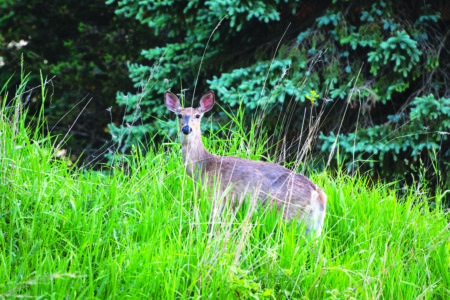Spongy moth caterpillars are already out and about
- Tara Bal/KISMA Three spongy moth egg masses on a yellow birch trunk. An old pupa case is also next to the bottom egg mass. The three holes in a row by the top egg mass were caused by a yellow-bellied sapsucker, a type of woodpecker
- Brandon Bal/KISMA Female spongy moths laying egg masses on firewood
- Sigrid Resh/KISMA Large spongy moth caterpillars on June 14, 2023

Tara Bal/KISMA Three spongy moth egg masses on a yellow birch trunk. An old pupa case is also next to the bottom egg mass. The three holes in a row by the top egg mass were caused by a yellow-bellied sapsucker, a type of woodpecker
Flowers are blooming, birds are chirping, and bugs are creeping! Spring has finally sprung in the Upper Peninsula. While many of our favorite plants and animals are waking up, some not-so-desirable invasive species are also making their presence known. One unwelcome species is the spongy moth (Lymantria dispar), formerly known as the gypsy moth. The spongy moth is native to Eurasia and was introduced to the eastern U.S. in 1869. Since then, spongy moths have steadily spread westward. Significant populations in Michigan were first detected in the 1980s and are now documented as present in every county of our state. The caterpillars of these moths feed on the leaves of many of our native trees and are particularly fond of oak and aspen leaves. Since their arrival, these caterpillars have defoliated millions of acres of trees in both our forests and around our homes.
Impacts of spongy moths
The invasive spongy moths experience boom and bust cycles within local populations. Approximately every ten years, this species experiences a temporary surge in their population size, which is known as an outbreak. During outbreaks, large numbers of caterpillars can completely defoliate trees. Defoliation typically takes place in June or July and can kill trees outright or weaken them, making them more susceptible to disease. Healthy trees can usually survive heavy defoliation during one growing season; however, additional stressors such as drought or preexisting diseases increase the chance of defoliation causing mortality. Tree growth and vigor are limited by years of defoliation, which also negatively impacts timber values. Additionally, these caterpillars can be a nuisance in large quantities, and contact with their fuzzy bodies can cause an allergic reaction in humans.
Spongy moth
identification

Brandon Bal/KISMA Female spongy moths laying egg masses on firewood
Adult spongy moths are approximately 1.5 inches in length. Males have pale gray to brown markings, and females are white. After emerging from their cocoons in late July through August, adult moths only live for a few days. You might begin to find their light tan egg masses with a spongy texture on trees, shrubs, and even firewood starting in late summer to early fall, which are still apparent right now in early spring. After overwintering, caterpillars begin hatching in spring: in the last week of May, we saw tiny spongy moth caterpillars crawling around in Houghton. Young caterpillars are tiny, black, and fuzzy. Mature caterpillars reach approximately 3 inches in length, have a black and yellow head, a fuzzy body, and 5 pairs of blue spots followed by 6 pairs of red spots along their back. You will likely find them in your yard congregating on tree trunks. On a sunny walk in the woods during an outbreak year, you may hear what sounds like rain but is actually caterpillar waste falling from the trees above!
What can you do?
Spongy moths are unfortunately beyond the point of eradication and are here to stay. Luckily, their populations are kept in check by a pathogen called nuclear polyhedrosis virus (NPV). NPV is transmitted orally and causes low mortality in small populations but high mortality in large populations and is partly responsible for the booms and busts we see. If you find egg masses on your favorite tree, you can scrape the eggs off into a bucket of soapy water. If you find a tree is already being defoliated by caterpillars, consider watering that tree weekly to prevent any potential drought stress. You can also wrap a band of burlap around the trunk of the susceptible tree. Spongy moth caterpillars will hide in this band during the day and can be periodically knocked off into a bucket of soapy water. Lastly, don’t transport firewood, as you can unknowingly introduce spongy moth eggs or other pests to new locations. The Midwest Invasive Species Information Network’s (MISIN) online reporting tool can be used to report invasive species like the spongy moth, aiding researchers in understanding shifting populations of invasive species (https://www.misin.msu.edu/report/misin/?project=misin).
References:
• Michigan DNR Spongy Moth webpage: https://www.michigan.gov/invasives/id-report/insects/spongy-moth

Sigrid Resh/KISMA Large spongy moth caterpillars on June 14, 2023
• 2022 Michigan Forest Health Highlights Report: Historic spongy moth outbreak begins to ease. Michigan DNR Forest Resources Division. Available online at: https://www.michigan.gov/dnr/managing-resources/forestry/health









